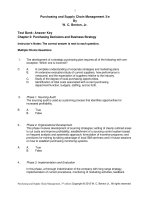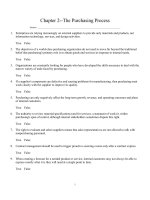Lecture Purchasing and supply chain management (3rd/e): Chapter 14 - W. C. Benton
Bạn đang xem bản rút gọn của tài liệu. Xem và tải ngay bản đầy đủ của tài liệu tại đây (658.07 KB, 17 trang )
Chapter 14:
Bargaining and
Negotiations
Purchasing and Supply Chain Management
3rd edition
Purchasing and Supply Chain Management, 3rd edition, Copyright © 2013, W. C. Benton Jr., All rights reserved.
Purchasing and Supply Chain Management, 3rd edition, Copyright 2013, W.
1
Content
•
Bargaining
•
Distributive bargaining
•
Integrative bargaining
•
Distributive bargaining experiment
•
Formal negotiation
2
Purchasing and Supply Chain Management, 3rd edition, Copyright © 2013, W. C. Benton Jr., All rights reserved.
Bargaining
•
Explicit bargaining
•
An interaction where parties with certain disagreements confer
and exchange ideas about a possible solution until a compromise
is reached or the bargaining is terminated
3
Purchasing and Supply Chain Management, 3rd edition, Copyright © 2013, W. C. Benton Jr., All rights reserved.
Negotiation
•
•
The preliminary discussion to bargaining
The terms bargaining and negotiation have been used
interchangeably.
4
Purchasing and Supply Chain Management, 3rd edition, Copyright © 2013, W. C. Benton Jr., All rights reserved.
Twoparty Bargaining
•
Bilateral monopoly system or twoparty bargaining
•
•
Bargaining that occurs between two parties who possess
resources the other desires
The 2 types of twoparty bargaining:
•
Distributive bargaining
•
•
Psychology
Integrative bargaining
•
Economics
5
Purchasing and Supply Chain Management, 3rd edition, Copyright © 2013, W. C. Benton Jr., All rights reserved.
Distributive Bargaining
•
Definition:
•
•
•
Bargaining where the total gains is “distributed” between the two
parties involved, and each party usually wants as much as it can
get
Without some degree of cooperation either party can
block the bargaining
Can use game theory
•
Varying sum bargaining
Zerosum bargaining
6
•
Purchasing and Supply Chain Management, 3rd edition, Copyright © 2013, W. C. Benton Jr., All rights reserved.
Payoff System
•
Factors related to the payoff system:
1.
The amount that has to be exceeded if the bargainer is to realize a
profit
2.
The cost of time spent in bargaining
3.
The cost of failure to reach agreement
4.
Added benefits achieved by obtaining a specific threshold value
5.
Qualitative or quantitative variations in the general level of payoff
values
6.
Whether payoffs are based solely on one’s own profit schedule or are
based, in whole or in part, on the degree to which one’s profits exceed
those of others
7.
Whether conflict is constantsum or varyingsum
7
Penalties the bargaining opponent (or perhaps a third party) is likely to
Purchasing and Supply Chain Management, 3rd edition, Copyright © 2013, W. C. Benton Jr., All rights reserved.
8.
Payoff System Factors
•
Breakeven Point
•
The amount that must be exceeded in the bargaining interaction
in order to obtain a profit
•
•
Bargaining is often an attempt to convince the other person to
accept a lower value than the one he or she maintains is
necessary
Bargainer’s resistance to making concessions is positively
correlated to
1.
The time required to make a further concession
2.
the probability of withdrawing from the negotiations
8
Purchasing and Supply Chain Management, 3rd edition, Copyright © 2013, W. C. Benton Jr., All rights reserved.
Psychological Bargaining Framework
•
Six major factors affecting bargaining:
1. General
bargaining
predispositions
6. Bargaining
strategy
2. Payoff system
Outcome
3. Social
relationship with
the opponent
5. Situational
factors
4. Social
relationship with
significant others
9
Purchasing and Supply Chain Management, 3rd edition, Copyright © 2013, W. C. Benton Jr., All rights reserved.
Bargaining Strategy
•
•
•
Tougher bargaining strategy
•
More extreme opening position
•
Fewer concessions
•
Smaller concessions
A consistent tough bargaining strategy (not fair) could
result in:
•
High transaction costs
•
Lack of future agreements
•
Replacement of the bargaining opponent
The best strategy:
10
Always reciprocating both the frequency and the magnitude of the
Purchasing and Supply Chain Management, 3rd edition, Copyright © 2013, W. C. Benton Jr., All rights reserved.
•
Content
•
Bargaining
•
Distributive Bargaining
•
Integrative Bargaining
•
Distributive Bargaining Experiment
11
Purchasing and Supply Chain Management, 3rd edition, Copyright © 2013, W. C. Benton Jr., All rights reserved.
Distributive Bargaining Experiment
•
•
Examines the effect of the contingency compensation on
both buyers and sellers
Situation
•
An agreement has to be reached on the specifications of the
product to be bought and the money to be paid
•
Both the seller and the buyer can make concessions
12
Purchasing and Supply Chain Management, 3rd edition, Copyright © 2013, W. C. Benton Jr., All rights reserved.
Distributive Bargaining Experiment (cont.)
•
Findings:
1.
The buyer’s initial offer is always above the seller’s reservation
price
2.
The negotiator’s payment system has significant effects
When only one party is contingently rewarded,
o
•
o
the effect is to shift the settlement in that party’s favor.
When both parties are contingently rewarded,
•
There is a much longer and more difficult negotiation process.
13
Purchasing and Supply Chain Management, 3rd edition, Copyright © 2013, W. C. Benton Jr., All rights reserved.
Distributive Bargaining Experiment (cont.)
•
Implication:
1.
Contingent rewards make a difference in negotiation outcomes
2.
Purchasing organizations need to be aware of the
salesperson’s reward system
3.
Management must develop stronger contingencies to
encourage purchasing effectiveness
14
Purchasing and Supply Chain Management, 3rd edition, Copyright © 2013, W. C. Benton Jr., All rights reserved.
Formal Negotiation
Seller’s Perspective
VS.
Buyer’s Perspective
15
Purchasing and Supply Chain Management, 3rd edition, Copyright © 2013, W. C. Benton Jr., All rights reserved.
The Buyer’s Procedure for a Formal
Negotiation
Followup
Develop tactics to achieve the strategy
Set strategy based on objectives
Develop the plan
Determine bargaining strength
Prepare a price/cost analysis
Determine objectives
Select team and chief negotiator
16
Purchasing and Supply Chain Management, 3rd edition, Copyright © 2013, W. C. Benton Jr., All rights reserved.
Questions?
17
Purchasing and Supply Chain Management, 3rd edition, Copyright © 2013, W. C. Benton Jr., All rights reserved.









